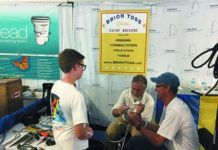We bought a test boat a few weeks ago-a 1988 Beneteau First 23.5. (Met her on the Internet. There was an attraction…)
Actually, the boat took me by surprise. I’d been looking on and off at boats that would, first of all, fit the budget, that wouldn’t need a ton of labor to put in shape or maintain; that could be sailed shorthanded, and that had the right combination of systems and components to host many of our tests and evaluations. I was looking at boats that were familiar and pleasing to my eye-the J/29 or J/30, the Express 27 (tough to find around here), C&C 27, Tartan 30, even the Vineyard Vixen 29 (also tough to find, although one occasionally becomes available).
What was holding me back was that I know better than to buy boats. You get the fever, but then you work your way through it, and you’re fine. Look, but don’t touch. Bring a duffle and let the other guy fret. The winter wind wakes you in the night, and you remember you have nothing in the water, and go back to sleep happily.
Then I ran across this Beneteau 23.5, which was listed right down the street for a good price. The more I looked, the more intrigued I became. I’ve never sailed one, and still haven’t, since there’s about a foot of snow on board at the moment. I knew about them by reputation only: “Good starter boat.” “Had a lot of fun, then moved up.” I visited some websites that had useful information and scuttlebutt about the boat.
Turns out this Beneteau should be just about ideal as a test boat-it has almost everything we need at the magazine, but in miniature: little bitty galley, little bitty nav station inside the little bitty enclosed head, little bitty roller-furling system, and so on. It has a holding tank and some plumbing. It has a 12-volt system with very French circuit breakers, and an outboard engine with an alternator. It has a light, deck-stepped rig, good-sized self-tailing Andersen winches (retrofitted), new sails, plenty of fiberglass, and just a little bit of wood.
She was designed by Groupe Finot, and looks a bit like a first-generation French Open-Class 60 with the middle 37 feet deleted. In fact she’s downright wedge-shaped. Word has it that she spins out if you heel her way over in a breeze, even with the very high-aspect rudder, and I don’t doubt it. She has no bilge to speak of, a flattish, planing bottom, a nicely shaped fin keel in good shape, and a plumb stem. She’s a bit modern, if you see what I mean…and a bit plasticky. But while she might not be the boat to bring home to mother, I think she’s fast. There’s a lot to be said for that.
She should also be good in light air, of which we have plenty in Long Island Sound, and will be easy to singlehand. Most of all, she won’t demand a lot of time, which is what we have the least of around here.
Then the problem was to name the boat. I have so far avoided looking at her current name, either in papers on in the vinyl lettering on the boat itself. It can be bad luck to rename a boat if you don’t follow certain arcane procedures, but the luck is worse if you connect with the previous name.
Practical Sailor’s previous test boat was called Viva. It’s a good name, but I don’t think we can use it again, especially because Viva was a very brawny Tartan 44. This little Beneteau triangle probably doesn’t weigh as much as Viva’s saloon table. No, I think a shorter, lighter boat warrants a shorter, lighter name: Viv. We can think of it as short for Vivian, a.k.a The Lady of the Lake, mistress of Merlin, or just as the root syllable of so many words we know about “living.” Also, there’s no way that anything female, going by the name of Viv, could be cranky by nature. There’s a lot to be said for that, too.
We’ll keep you posted on this boat through the cleaning up, bottom painting, equipping, provisioning…
Oh, man, here we go again.
-Doug Logan



































